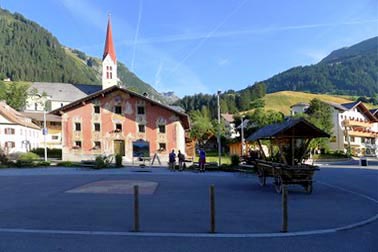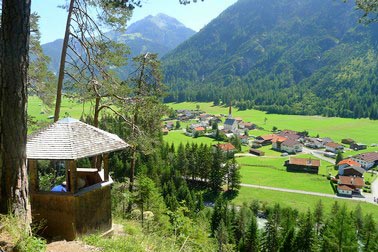|
G3VGR
|
LECHWEG Steeg - Elbigenalp
|
 One advantage to basing oneself in a central location is that it isn't necessary to walk all the stages sequentially. As the weather forecast for Wednesday promised hot, sunny weather, I decided to swap around stages 3 and 4.
I didn't want another day of being up in the mountains with no view of them.
This plan worked, as I woke up to brilliant sunshine and caught the bus to Steeg after breakfast.
Shortly after leaving Steeg by following the river bank, I crossed the Dickenauer Brücke, a wooden bridge over the Lech and almost immediately reached the impressive Griesbach waterfall.
After crossing the rickety wooden footbridge at the bottom of the falls, I started on the Jochweg towards Holzgau.
This was a very enjoyable walk as it started out following the river bank.
However, the trail was in the shadow of some large mountains, so I had to wear my windshirt for a while.
The view and sounds of the Lech on my left side was pleasant enough, but the right side of the path was a treasure trove of many interesting plants, some laden with various berries.
They seemed to thrive in the wetness and the shade from the mountain above.
The Jochweg turned upwards and away from the river into a beautiful forest with many larch trees.
This was made more impressive by the sunlight shining through the trees.
After reaching the edge of the forest, I followed the trail through some farm fields, then crossed the main road to reach the imposing Maria Himmelfahrt church at Holzgau.
One advantage to basing oneself in a central location is that it isn't necessary to walk all the stages sequentially. As the weather forecast for Wednesday promised hot, sunny weather, I decided to swap around stages 3 and 4.
I didn't want another day of being up in the mountains with no view of them.
This plan worked, as I woke up to brilliant sunshine and caught the bus to Steeg after breakfast.
Shortly after leaving Steeg by following the river bank, I crossed the Dickenauer Brücke, a wooden bridge over the Lech and almost immediately reached the impressive Griesbach waterfall.
After crossing the rickety wooden footbridge at the bottom of the falls, I started on the Jochweg towards Holzgau.
This was a very enjoyable walk as it started out following the river bank.
However, the trail was in the shadow of some large mountains, so I had to wear my windshirt for a while.
The view and sounds of the Lech on my left side was pleasant enough, but the right side of the path was a treasure trove of many interesting plants, some laden with various berries.
They seemed to thrive in the wetness and the shade from the mountain above.
The Jochweg turned upwards and away from the river into a beautiful forest with many larch trees.
This was made more impressive by the sunlight shining through the trees.
After reaching the edge of the forest, I followed the trail through some farm fields, then crossed the main road to reach the imposing Maria Himmelfahrt church at Holzgau.
Obviously, I didn't need to spend any time today exploring Holzgau because I was lodging here for the duration of my trip.
Holzgau really is a pretty village with it's 18th Century Lüftlmalerei decorated buildings and also very friendly residents.
One of the locals had told me that Holzgau is the "Pearl of the Lechtal".
This may be true, however it should be noted that he told me this late one evening in the Dorfalm after copious amounts of Weizenbier.
From the church, I followed the trail up through the Höhenbachschlucht, a steep sided gorge.
Just after the start of the gorge, I could see the Holzgau Hanging Bridge, spanning the gorge high above me.
At over 200 metres long and 110 metres high, it is the longest and probably most spectacular suspension footbridge in Austria.
I carried on up the gorge to the Simms Wasserfall and onward to the Cafe Uta.
The waterfall is named after Frederick Simms, a British automotive engineer who created the waterfall in 1907 by blasting.
At the Cafe Uta, the trail sharply switched back and upwards. After a kilometre, I took the option of turning off in the forest to the suspension bridge instead of continuing towards the Panoramaweg.
Feeling like I was in an Indiana Jones movie, I started across the bridge.
It was swaying as I made my way across.
Looking down through the steel grates at the bottom of the gorge 110 metres below was an interesting experience.
I was now on the wrong side of the gorge, so re-crossed the bridge to start on the Panoramaweg towards Bach.
After exiting a short section in forest, the path continued along the Schiggen, a high plateau on the mountainside. Some boardwalks had been installed over the boggy sections of the path.
From here, there were excellent views of the green valley below, with the many hay barns and the villages of Holzgau and Stockach.
Near Stockach, the trail entered the Benglerwald, a large forest and became quite a demanding mountain path.
There were occasional views of the valley through the trees.
After a few kilometres, the trail descended steeply down to the river at a point where a covered wooden bridge could be crossed to exit to Stockach.
Instead of taking this option, I climbed back up through the forest and arrived at the valley station of the Jöchelspitzbahn.
I was tired from the heat and the rough forest path so stopped here for lunch at the Lechtaler Hexenkessel alpine restaurant next to the chairlift.
After a long lunch, much of the afternoon was spent in an alcoholic haze.
From the restaurant, I followed the trail through Seesumpf, a picturesque area of alpine farms until I reached another forest.
I was descending through the forest and was totally surprised to find the diminutive Mariahilf Chapel in a small clearing.
This is in a beautiful setting and the congregation is from the local farms. From the chapel, it was a steep descent through the forest.
and I managed to avoid treading on a long, skinny, brown snake who was slithering down the path before me, trying to avoid my boots.
Some of the trees had framed pictures depicting events from the New Testament.
The descent ended at a much bigger church, beside the river at Bach.
This ended the interesting (and demanding) part of today's stage.
From the church at Bach, the trail was completely flat, following the Lech for about 4Km to Elbigenalp.
The trail actually avoids Elbigenalp by keeping next to the river bank, which is no loss as it isn't a very interesting village.
Despite having a nice church, the village is drawn out for about a kilometre and I never saw a dorfplatz or other sign of a centre of the community.
I followed a dried river bed from the Lech and ended at a large supermarket opposite the Hotel Alpenrose where there was a bus stop.

On the outskirts of Steeg
|

Griesbach Wasserfall
|

View upstream from the Jochweg
|

Following the Jochweg through the forest
|

View to Holzgau from Dürnau
|

Holzgau Dorfplatz
|

Entrance to Höhenbachschlucht
|

Simms Wasserfall
|

Holzgau Hängerbrücke
|

View to Holzgau and Lechtal from Panoramaweg
|

Stochach viewed from Benglerwald
|

The Lech at Stockach
|

Lechtaler Hexenkessel
|

A Brotzeit Teller for lunch at the Hexenkessel
|

The Lechweg through Seesumpf
|

The little Mariahilf Chapel
|

Bach - parish church and bridge over the Lech
|

Pedestrian bridge at Elbigenalp
|

View upstream at Elbigenalp
|

Elbigenalp - St. Nikolaus Parish Church
|
[Home]
 One advantage to basing oneself in a central location is that it isn't necessary to walk all the stages sequentially. As the weather forecast for Wednesday promised hot, sunny weather, I decided to swap around stages 3 and 4.
I didn't want another day of being up in the mountains with no view of them.
This plan worked, as I woke up to brilliant sunshine and caught the bus to Steeg after breakfast.
Shortly after leaving Steeg by following the river bank, I crossed the Dickenauer Brücke, a wooden bridge over the Lech and almost immediately reached the impressive Griesbach waterfall.
After crossing the rickety wooden footbridge at the bottom of the falls, I started on the Jochweg towards Holzgau.
This was a very enjoyable walk as it started out following the river bank.
However, the trail was in the shadow of some large mountains, so I had to wear my windshirt for a while.
The view and sounds of the Lech on my left side was pleasant enough, but the right side of the path was a treasure trove of many interesting plants, some laden with various berries.
They seemed to thrive in the wetness and the shade from the mountain above.
The Jochweg turned upwards and away from the river into a beautiful forest with many larch trees.
This was made more impressive by the sunlight shining through the trees.
After reaching the edge of the forest, I followed the trail through some farm fields, then crossed the main road to reach the imposing Maria Himmelfahrt church at Holzgau.
One advantage to basing oneself in a central location is that it isn't necessary to walk all the stages sequentially. As the weather forecast for Wednesday promised hot, sunny weather, I decided to swap around stages 3 and 4.
I didn't want another day of being up in the mountains with no view of them.
This plan worked, as I woke up to brilliant sunshine and caught the bus to Steeg after breakfast.
Shortly after leaving Steeg by following the river bank, I crossed the Dickenauer Brücke, a wooden bridge over the Lech and almost immediately reached the impressive Griesbach waterfall.
After crossing the rickety wooden footbridge at the bottom of the falls, I started on the Jochweg towards Holzgau.
This was a very enjoyable walk as it started out following the river bank.
However, the trail was in the shadow of some large mountains, so I had to wear my windshirt for a while.
The view and sounds of the Lech on my left side was pleasant enough, but the right side of the path was a treasure trove of many interesting plants, some laden with various berries.
They seemed to thrive in the wetness and the shade from the mountain above.
The Jochweg turned upwards and away from the river into a beautiful forest with many larch trees.
This was made more impressive by the sunlight shining through the trees.
After reaching the edge of the forest, I followed the trail through some farm fields, then crossed the main road to reach the imposing Maria Himmelfahrt church at Holzgau.



















